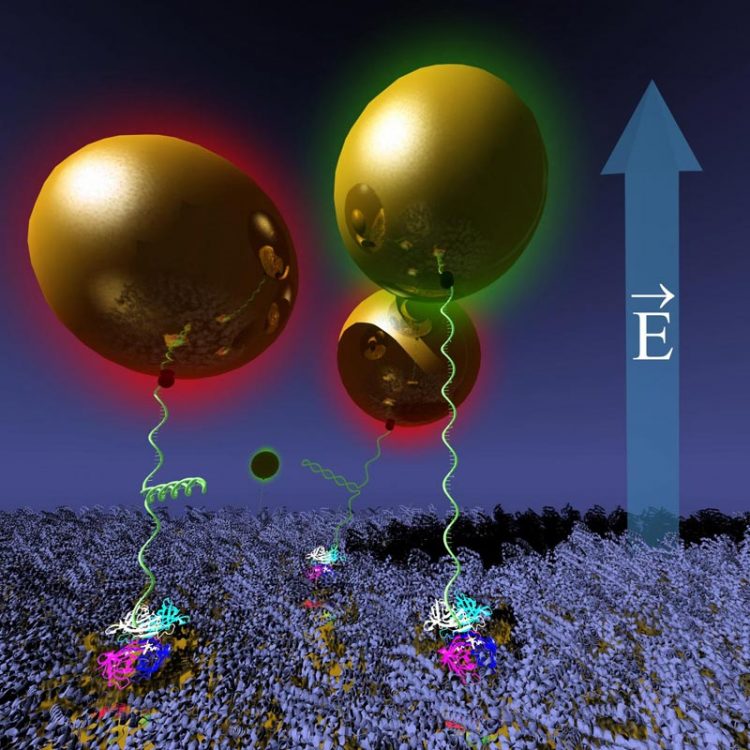A novel nanoactuator system has been developed

Gold nanoparticles tethered on a BSA-protein-protected gold surface via hairpin-DNA are moved reversibly using electric fields, while monitoring their position and DNA conformation optically via changes of its plasmon resonance (by color). Credit: Jussi Toppari
Over the past decades, nanoactuators for detection or probing of different biomolecules have attracted vast interest for example in the fields of biomedical, food and environmental industry.
To provide more versatile tools for active molecular control in nanometer scale, researchers at University of Jyväskylä and University of Tampere have devised a nanoactuator scheme, where gold nanoparticle (AuNP) tethered on a conducting surface is moved reversibly using electric fields, while monitoring its position optically via changes of its plasmon resonance.
Forces induced by the AuNP motion on the molecule anchoring the nanoparticle, can be used to change and study its conformation.
– Related studies use either organic or in-organic interfaces or materials as probes. Our idea was to fuse these two domains together to achieve the best from the both worlds, says postdoctoral researcher Kosti Tapio.
More possibilities to study molecules
According to the current study, it was shown that AuNPs anchored via hairpin-DNA molecule experienced additional discretization in their motion due to opening and closing of the hairpin-loop compared to the plain, single stranded DNA.
– This finding will enable conformational studies of variety of multiple interesting biomolecules, or even viruses, says Associate Professor Vesa Hytönen from the Protein Dynamics Group from the University of Tampere.
Besides studying the structure and behaviour of molecules, this scheme can be extended to surface-enhanced spectroscopies like SERS, since the distance between the particle and the conducting surface and hence the plasmon resonance of the nanoparticle can be reversibly tuned.
– Nanoparticle systems with post-fabrication tuneable optical properties have been developed in the past, but typically the tuning processes are irreversible. Our approach offers more customizability and possibilities when it comes to the detection wavelengths and molecules, states Associate Professor Jussi Toppari from the University of Jyväskylä.
###
The research was funded by the Academy of Finland (OMA – programmable materials) and the Finnish Cultural Foundation (the Central Finland Regional Fund). Authors thank BioNavis Ltd for equipment and essential expertise in the SPR analysis.
Additional information:
– Associate Professor Jussi Toppari, j.jussi.toppari@jyu.fi, +358 40 8054123 Molecular Electronics and Plasmonics Group, Department of Physics and Nanoscience Center, University of Jyväskylä, Finland.
– Associate Professor Vesa Hytönen, vesa.hytonen@uta.fi, +358 40 1901517 Protein Dynamics Group, Faculty of Medicine and Life Sciences and BioMediTech, University of Tampere, Finland.
– Post-doctoral Researcher Kosti Tapio, kostapio@uni-potsdam.de, +358 50 5118827 Optical Spectroscopy and Chemical Imaging, Department of Chemistry, University of Potsdam, Germany.
– Reference: K. Tapio, D. Shao, S. Auer, J.-P. Tuppurainen, M. Ahlskog, V.P. Hytönen and J. Toppari, DNA-nanoparticle actuator enabling optical monitoring of nanoscale movements induced by electric field, Nanoscale
– Link to the article: http://dx.
Media Contact
More Information:
http://dx.doi.org/10.1039/C8NR05535AAll latest news from the category: Physics and Astronomy
This area deals with the fundamental laws and building blocks of nature and how they interact, the properties and the behavior of matter, and research into space and time and their structures.
innovations-report provides in-depth reports and articles on subjects such as astrophysics, laser technologies, nuclear, quantum, particle and solid-state physics, nanotechnologies, planetary research and findings (Mars, Venus) and developments related to the Hubble Telescope.
Newest articles

Security vulnerability in browser interface
… allows computer access via graphics card. Researchers at Graz University of Technology were successful with three different side-channel attacks on graphics cards via the WebGPU browser interface. The attacks…

A closer look at mechanochemistry
Ferdi Schüth and his team at the Max Planck Institut für Kohlenforschung in Mülheim/Germany have been studying the phenomena of mechanochemistry for several years. But what actually happens at the…

Severe Vulnerabilities Discovered in Software to Protect Internet Routing
A research team from the National Research Center for Applied Cybersecurity ATHENE led by Prof. Dr. Haya Schulmann has uncovered 18 vulnerabilities in crucial software components of Resource Public Key…





















